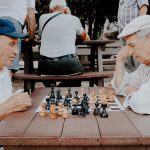Space Changes DNA and NASA Doesn’t Know Why
In March of 2015, astronaut Scott Kelly embarked on a mission unprecedented in the history of American space travel.
It was to be a one-year mission, the longest ever attempted by an American astronaut. During this time, NASA would study the effects of spaceflight on the human body. Some studies like this had been done before, but this one was different.
Scott Kelly, you see, had an identical twin brother. Their DNA sequences were absolutely the same, which meant that NASA had the opportunity for an almost perfectly controlled experiment. By comparing changes in one astronaut’s body with changes in the other, they could see exactly what space does to humans.
They released a batch of initial findings in 2017, and more is expected to come throughout this year. What they’ve found so far, though, has seriously surprised them.
To understand what the NASA researchers discovered, we’ll first have to brush up on a little basic genetics. Basically, all of the DNA in our cells is stored in bundles called chromosomes. On the end of every one of these chromosomes, we have these caps called “telomeres.” These are strings of junk DNA molecules that protect our actual genes.
On earth, these caps typically get shorter every time a cell divides. We don’t entirely understand how all of it works right now, but this has been linked to aging and cell degeneration. When the caps get shorter, you get older. And they tend to shorten a lot faster when you’re in the middle of stressful situation—like, say, one of the longest spaceflights ever attempted.
That is what makes Kelly’s case so weird. His telomeres didn’t shorten in space at all. In fact, NASA has now confirmed that they actually got longer. And not just that, but they quickly bounced back to about their original lengths as soon as he touched back down on earth.
What does this mean? Well, that’s the thing—nobody knows.
“This is exactly the opposite of what we thought,” radiation biologist Susan Bailey told the science journal Nature.
Now, NASA says that some of this lengthening might be because of the better nutrition and exercise Kelly was getting while in space. But even they admit that that’s a sort of flimsy argument, especially since it doesn’t explain why his telomeres bounced back so quickly once he touched down on earth.
Kelly’s case is something of a mystery in science right now. And who knows—it might just bring us one step closer to the secret of immortality.
This wasn’t the only interesting finding of the Kelly expedition either. Remember, he had a twin brother back on earth through his entire trip, so researchers were always able to directly compare changes Scott Kelly went through with what was happening to his brother.
Even though the two men both had identical DNA sequences, Scott’s time in space seriously changed the way those genes were expressed. A full 7% of his genes have shown long-lasting changes, which is something the scientists were not expecting.
To be clear, the actual molecules that make up Kelly’s DNA chains didn’t actually change by 7% while he was in space. That much mutation would have transformed him into something else altogether, or killed him (remember, the DNA of every single human on this planet is about 99.9% similar).
Instead, all this change really comes down to the way the DNA was expressed. Now, it’s not super uncommon for unusual stresses on the body to bring changes in our body’s responses. That happens to all of us, and NASA has explained that Kelly’s body went through a lot of oxygen deprivation, inflammation, and changes in nutrition while in space that affected his gene expression by quite a bit.
What they weren’t expecting, though, was for these changes to stick around for long after Kelly came back down. It’s led some to start calling these permanent genetic changes “the space gene.”
According to NASA, “the remaining 7% [of changed genes] point to possible longer-term changes in genes related to his immune system, DNA repair, bone formation networks, hypoxia, and hypercapnia.” (Hypoxia = having too little oxygen in your bloodstream. Hypercapnia = having too much carbon dioxide in your bloodstream).
What does all of this mean for the future of space travel? Well, on the one hand, it points to just how little we really know about how the body works once you get away from earth. The human body is incredibly complex, and we don’t fully understand what stresses in space and on other planets might do to it.
On the other hand, though, Kelly came out of this whole experiment in good health, both mentally and physically. If space organizations could get the funding to send a mission to Mars, there don’t seem to be too many health-related reasons that would keep them from going. The right spacecraft could get to Mars in just a couple hundred days, and research on people like Scott Kelly is making missions like this seem more and more possible all the time.
What might be more exciting about these findings, though, is how much they show us about what we don’t yet know. We don’t fully understand DNA expression. We don’t yet know how different people might react to the activation of these “space genes.” And we definitely don’t understand what was going on with Kelly’s telomeres.
As NASA continues to push the boundaries of what we thought was possible for space travel, so too does modern science continue to push the boundaries of what we thought was possible for the human body. Who knows what new frontiers lie undiscovered? Who knows what the future of these kinds of research might hold?
We’ll just have to wait to find out.



